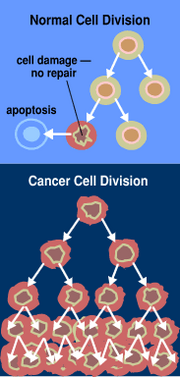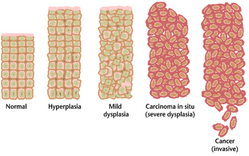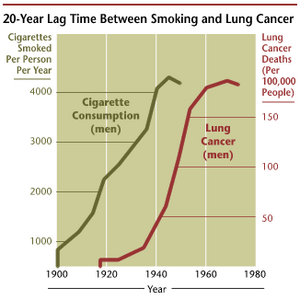Cancer
Cancer is a class of diseases characterized by uncontrolled division of cells and the ability of these cells to invade other tissues, either by direct growth into adjacent tissue (invasion) or by implantation into distant sites (metastasis). This unregulated growth is caused by damage to DNA, resulting in mutations to genes that control cell division. Several mutations may be required to transform a normal cell into a malignant cell. These mutations are often caused by chemicals or physical agents called carcinogens. Some mutations occur spontaneously, or they can be inherited (germ line mutations.) more...
Cancer can cause many different symptoms, depending on the site and character of the malignancy and whether there is metastasis. Cancer may be painless. A definitive diagnosis usually requires the histologic examination of tissue by a pathologist. This tissue is obtained by biopsy or surgery. Once diagnosed, cancer is usually treated with surgery, chemotherapy, or radiation.
If untreated, cancers may eventually cause death. Cancer is mainly a disease of later years, and is one of the leading causes of death in developed countries. Most cancers can be treated and many cured, especially if treatment begins early. Many forms of cancer are associated with exposure to environmental factors, such as tobacco smoking, alcohol, and certain viruses. Some of these can be avoidable, and public health and vaccination programmes are important on a global scale.
History
Hippocrates described several kinds of cancers. He called benign tumours oncos, Greek for swelling, and malignant tumours carcinos, Greek for crab or crayfish. This strange choice of name probably comes from the appearance of the cut surface of a solid malignant tumour, with a roundish hard center surrounded by pointy projections, vaguely resembling the silhouette of a crab. He later added the suffix -oma, Greek for swelling, giving the name carcinoma. Today, carcinoma is the medical term for a malignant tumour derived from epithelial cells. It is Celsus who translated carcinos into the latin cancer, also meaning crab. Galen used "oncos" to describe all tumours, the root for the modern word oncology.
Classification and nomenclature
Cancers are classified by the type of cell that resembles the tumor and, therefore, the tissue presumed to be the origin of the tumor. The following general categories are usually accepted:
- Carcinoma: malignant tumors derived from epithelial cells. This group represent the most common cancers, including the common forms of breast, prostate, lung and colon cancer.
- Lymphoma and Leukemia: malignant tumors derived from blood and bone marrow cells
- Sarcoma: malignant tumors derived from connective tissue, or mesenchymal cells
- Mesothelioma: tumors derived from the mesothelial cells lining the peritoneum and the pleura.
- Glioma: tumors derived from brain cells
- germ cell tumours: tumors derived from germ cells, normally found in the testicle and ovary
- Choriocarcinoma: malignant tumors derived from the placenta
Malignant tumors are usually named using the Latin or Greek root of the organ as a prefix and the above category name as the suffix. For instance, a malignant tumor of liver cells is called hepatocarcinoma; a malignant tumor of the fat cells is called liposarcoma. For common cancers, the English organ name is used. For instance, the most common type of breast cancer is called ductal carcinoma of the breast or mammary ductal carcinoma. Here, the adjective ductal refers to the appearance of the cancer under the microscope, resembling normal breast ducts.
Read more at Wikipedia.org




